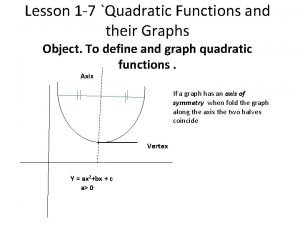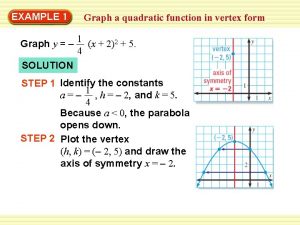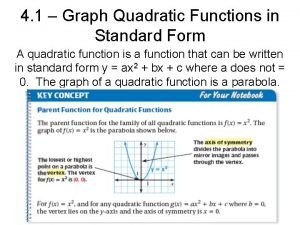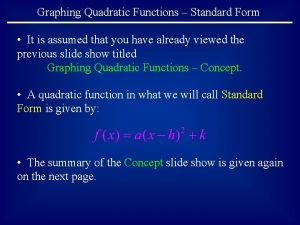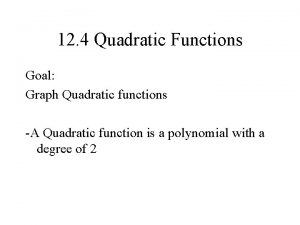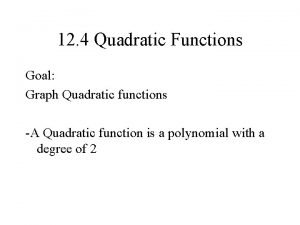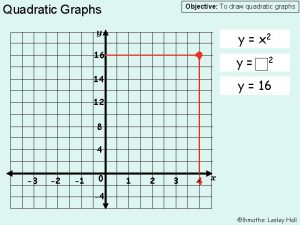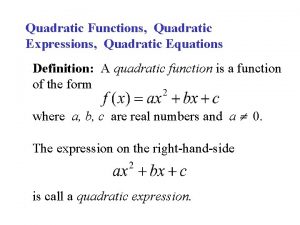Graphs of Quadratic Functions Part 2 Graph Quadratic












- Slides: 12

Graphs of Quadratic Functions Part 2

Graph Quadratic Functions Refresher: Standard Form: f(x) = 2 ax + Shape: Parabola When in standard form, If a is positive, the parabola opens up y = ax 2+bx+c If a is negative, the parabola opens down y = -ax 2+bx+c bx + c

Parts of Parabolas Refresher : Axis of Symmetry Vertex Find the equation for the axis of symmetry from points: 1. (3, 10) and (15, 10) 1. Since these ordered pairs are points of symmetry (same yvalue), you can find the axis of symmetry. 2. The middle of 3 and 15 is 9. 3. The axis of symmetry would be x = 9.

Parts of Parabolas Refresher : y = x 2 – 2 x – 3 y = (1)2 – 2(1) – 3 y = -4 Vertex (1, -4)

Graph Quadratic Functions Refresher:

Quadratic Graphs Vocabulary x-intercepts = Where the function crosses the x axis. There could be 2, 1, or no intercepts. Synonyms for x-intercepts: “roots of the function”, “zeros of the function”, “solutions to the function” Minimum value of function = y-value of minimum = the y coordinate of the vertex if parabola opens up and vertex is a min. Maximum Value of function = y-value of maximum= the y coordinate of the vertex if parabola opens down and if vertex is a max.

Transformations on Quadratic Graphs Translate = slide or shift adding/subtracting to the y value shifts up and down (it adds onto the end of the function and changes the y-int) c(x)=x 2 + 3 is 3 units higher than g(x)=x 2 d(x)=x 2 - 3 is 3 units lower than g(x)=x 2 adding/subtracting to the x value shifts right and left (it affects the zeros) k(x)=(x - 3)2 is 3 units to the right of g(x)=x 2 j(x)=(x + 3)2 is 3 units to the left of g(x)=x 2

Transformations on Quadratic Graphs Dilate = to change size / stretch

Quadratic Graphs Vocabulary End Behavior of a Graph: If a > 0, then f(x) opens up and has a minimum y value (at the coordinate of the vertex) f is decreasing for x-values less than, or to the left of, the vertex, f is increasing for x-values greater than, or to the right of, the vertex If a < 0, then f(x) opens down has a maximum y value (at x-coordinate of the vertex) f is increasing for x-values less than, or to the left of, the vertex, f is decreasing for x-values greater than, or to the right of, the vertex

Graphs of Quadratic Functions – Graph A Look at the table and the graph, state points of symmetry. x f(x) -1 8 0 3 (-1, 8) and (5, 8) 1 0 2 -1 3 0 4 3 5 8 (0, 3) and (4, 3) What interval is the graph increasing? [2, ∞] What interval is the graph decreasing? [-∞, 2] Domain of Graph? Set of all real numbers Range of Graph? Set of all real numbers > -1 y > -1

Graphs of Quadratic Functions – Graph B Look at the table and the graph, state points of symmetry. x f(x) -5 -5 -4 0 (-5, -5) and (1, -5) -3 3 (-4, 0) and (0, 0) -2 4 -1 3 0 0 1 -5 What interval is the graph increasing? [-∞, -2] What interval is the graph decreasing? [-2, ∞] Domain of Graph? Set of all real numbers Range of Graph? Set of all real numbers < 4 y<4

Patterns in the tables of values… Table A Table B x f(x) -1 8 -5 -5 0 3 -4 0 1 0 -3 3 2 -1 -2 4 3 0 -1 3 4 3 0 0 5 8 1 -5 Do Tables A and B … have the same y-intercepts? have the same x-intercepts? Have the same maximum / minimum? Both open up? Are both symmetric? What patterns do you see in the tables of values? How can we know the x-coordinate of the vertex by looking at two symmetric points? How can you tell if they will open up or down and have the same end behavior without graphing?
 5-3 practice polynomial functions
5-3 practice polynomial functions Quadratic functions and their graphs
Quadratic functions and their graphs Sketch graph of quadratic function
Sketch graph of quadratic function Transformations of quadratic functions
Transformations of quadratic functions How to find the vertex of a quadratic equation
How to find the vertex of a quadratic equation Example of narrowest graph
Example of narrowest graph 4-1 graphing quadratic functions
4-1 graphing quadratic functions Using transformations to graph quadratic functions
Using transformations to graph quadratic functions Graph using transformations
Graph using transformations 9-4 transforming quadratic functions
9-4 transforming quadratic functions How to know if a graph opens up or down
How to know if a graph opens up or down How to graph quadratic functions in standard form
How to graph quadratic functions in standard form How to graph quadratic functions in intercept form
How to graph quadratic functions in intercept form

